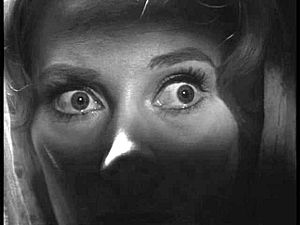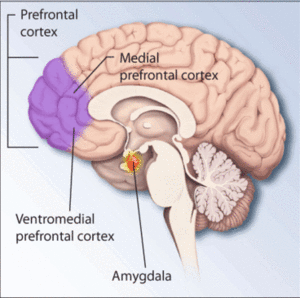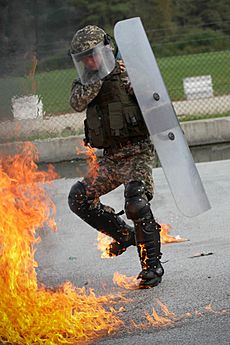Phobia facts for kids
A phobia comes from a Greek word meaning "fear." It is a very strong fear of a certain thing or situation. In psychology, a phobia is seen as a type of anxiety disorder.
A phobia is much more than just being scared of something. The fear is so strong that it can really affect a person's life. For example, someone with a phobia will often try very hard to avoid what they fear. If they cannot avoid it, they might feel extreme anxiety. This can make it hard for them to be with friends, do well at school or work, or enjoy everyday life.
There are two main kinds of phobias: specific phobias and social phobias. People with specific phobias fear one particular thing. This could be spiders (called arachnophobia) or high places (called acrophobia). People with social phobias fear social situations. This might include speaking in public, being in crowded places, or just being around other people.
Contents
What's the Difference: Phobia vs. Fear?
Fear is a normal human emotion. A phobia is different from regular fear in several ways:
- With phobias, a person fears something that is not truly dangerous, or not as dangerous as they believe. For example, many people dislike spiders. But someone with a spider phobia might panic just thinking about a spider. They might refuse to leave home because they are too scared of seeing one. They might even spend hours checking their home for spiders. People with phobias often know that their fear is much stronger than it should be.
- A phobia lasts much longer than regular fear. For example, someone with a spider phobia might feel very anxious for hours after seeing a spider.
- When a person feels normal fear, it usually does not harm their daily life. Phobias, however, can cause big problems. They might damage important friendships or make it hard for someone to work or go to school. People with social phobias might avoid being with others or meeting new people.
It is hard to know exactly how many people have phobias. Experts think that about 5 to 13 out of every 100 people might have a phobia. Women seem to have phobias about twice as often as men.
Why Do People Get Phobias?
There are many reasons why someone might develop a phobia.
What Can Cause a Phobia?
Phobias can be caused by:
- They often start in childhood.
- Sometimes, fears can be natural or built-in.
- A very scary or traumatic event can cause a phobia. This could be an assault, seeing an assault, or getting hurt.
- Hearing about a possible danger can also cause a phobia. For example, hearing about someone being attacked by an animal, or hearing about a natural disaster.
Things That Increase Risk
Some things can make a person more likely to develop a phobia:
- Family influence and culture can play a role.
- Certain personality traits or other disorders can increase the risk.
- Some people are naturally more sensitive or easily worried. This makes them more likely to develop phobias.
- A lack of interest or support from parents might also be a factor.
- Gender can matter. Women are more likely to have phobias than men.
Different Kinds of Phobias
Specific Phobias
These are also called psychological phobias. There are hundreds of different types! Here are some examples:
- Aichmophobia - fear of sharp objects, like scissors or needles.
- Bacillophobia - fear of bacteria.
- Claustrophobia - fear of small, closed-in spaces.
- Necrophobia - fear of death.
- Pharmacophobia - fear of medications.
- Taphophobia - fear of being buried alive.
- Blood-Injection-Injury phobias - fear of blood, injections, or injuries.
- Zoophobias - fear of one, several, or all animals. Some specific animal phobias include Arachnophobia (fear of spiders), Cynophobia (fear of dogs), Entomophobia (fear of insects), Ophidiophobia (fear of snakes), and Scoleciphobia (fear of worms).
Social Phobias
- Sociophobia - fear of people and/or social situations.
- Glossophobia – fear of speaking in public.
What Are the Symptoms of a Phobia?
When someone with a phobia comes across what they fear, they can experience both physical and psychological symptoms. This can happen if they actually see the thing, think about it, or even see a picture of it. How strong the symptoms are depends on how intense the fear is.
Psychological Symptoms
These symptoms happen in a person's mind:
- Feeling very anxious, sometimes leading to a panic attack.
- A strong want to run away.
- Feeling shaky or having tremors.
- Fear of losing control or going crazy.
- Fear of death.
- Fear of losing consciousness.
- Feeling nervous and restless.
Physical Symptoms
These symptoms happen in a person's body:
- Difficulty breathing or shortness of breath.
- Fast heart beat and increased heart rate.
- Shaking or tremors.
- More sweating.
- Feeling unwell, like feeling sick.
- Weakness, sometimes leading to fainting.
- Feeling a rush of hot or cold.
- Dry mouth.
- Pain or spinning in the head.
- A sudden need to go to the toilet.
How Are Phobias Treated?
There are different ways to help people who have phobias. There is treatment available that helps the patient become less sensitive to their fear. It can also teach them how the cycle of fear works. There are also medications, mostly sedatives, that can help people cope with their anxiety. Finally, self-help groups can provide support and understanding.
See also
 In Spanish: Fobia para niños
In Spanish: Fobia para niños




